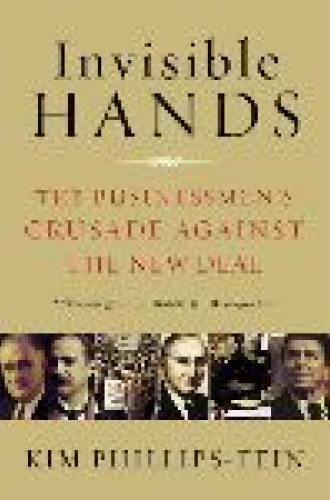The old new right
Long before the shouting contests over national health care and decades before Tea Partiers raised a collective ARGHHH!, a conservative, antigovernment movement was forged. The problem with government, these activists said, is that there is too much of it. When taxes and regulation go down, happiness and good will go up. For decades American conservatives have called for the market to do its magic work without interference.
Adam Smith penned his famous lines about the nature of humans and the market in 1776. He argued that when individuals seek their own gain, they will be led “by an invisible hand” to promote the good of all. Smith used the phrase “invisible hand” only twice in The Wealth of Nations. Still, its power to explain macroeconomics has been immense. To some it’s a poetic metaphor that well describes a natural, self-regulating process. To others it looks like frightening flimflam, a justification for an enormous con job. The larger-than-life 20th-century economist John Maynard Keynes thought Smith’s notion of an invisible hand overly rational and optimistic, a useless invention. It smacked of philosopher William Paley’s idea of a well-ordered universe. Enlight ened selfishness doesn’t work.
Many American conservatives have lauded the work of the invisible hand while slapping the visible, meddling hands of the government. “Take your hands off!” Barry Goldwater seems to say in his 1960 manifesto, The Conscience of a Conservative. “Our tendency to concentrate power in the hands of a few men deeply concerns me,” the senator from Arizona fretted. “We can be conquered by bombs or by subversion; but we can also be conquered by neglect—by ignoring the Constitution and disregarding the principles of limited government.”
Adam Smith’s grand theory had many helping hands, from movement leaders like Goldwater and Jerry Falwell, to business giants like Pierre du Pont and J. Howard Pew, to thinkers like Ludwig von Mises and Friedrich von Hayek. All arrayed themselves against New Deal policies, and many lashed out at Protestant liberalism.
Kim Phillips-Fein’s page-turner Invis ible Hands: The Businessmen’s Crusade Against the New Deal is a riveting history of the men, think tanks and movements that launched the conservative revolution. Other historians, like Lisa McGirr, Matt Lassiter and Donald Critchlow, have covered similar ground. Yet no one has spanned the decades with such an ironic sensibility and clear style. The book will be an eye opener for those unfamiliar with the steady growth of the ideological right in the years before 1950, when Lionel Trilling famously wrote, “For it is a plain fact that nowadays there are no conservative or reactionary ideas in general circulation.”
Phillips-Fein highlights
those determined few, those ordinary businessmen (and I use the word advisedly, for they were mostly men) from companies of different sizes and from various industries, who worked for more than forty years to undo the system of labor unions, federal social welfare programs, and government regulation of the economy that came into existence during and after the Great Depression of the 1930s.
The shock troops of this movement worked to educate the public about free-market principles and the hazards of Big Government. Members of the Liberty League, the National Association of Manufacturers, the Chamber of Com merce, the American Enterprise Institute and the Foundation for Econom ic Education all hoped to reach a broad public to let Americans know that theirs is a deeply conservative nation, committed to liberty and individualism. Such groups recorded speeches and sent out pamphlets, books and magazines to businessmen and local leaders.
A fairly typical stalwart was the owner of a West Virginia lumber company who in 1960 asked others to lend a hand in the economic education effort: “I am sure you agree with me that our headlong plunge into Socialism must be stopped. If it is, it will be up to us industrialists and businessmen to do the job.”
That boldness came only after years of struggle, observes Phillips-Fein. It was a tough road for conservative ideologues in the thirties. Alf Landon’s disastrous run for the presidency in 1936 seemed to confirm that business conservatives were “politically meaningless,” representing the interests of a tiny minority of nabobs and tycoons. They were out of step, like crew-cut John Birchers at a Haight-Ashbury love-in.
But political winds favored conservative causes after World War II. Harry Truman’s civil rights platform irked southerners so much that they formed the Dixiecrat breakaway party, and Repub licans gained substantially as the president’s approval ratings fell through the floor. Added to that, notes Phillips-Fein, McCarthyism made the right respectable. So did William F. Buckley Jr., the talented phenom from Yale, who started his National Review to some fanfare in 1955.
For all the gravitas that the National Review or the American Enterprise Institute lent the right, there were plenty of kooks waiting in the wings, arms cradling conspiracy-theory tracts and eyes scanning the horizon for commies. Rowdy John Birchers and the paranoid style of anticommunist demagogues like Fred Schwarz and Billy James Hargis worried many in the larger movement.
Phillips-Fein tells the full story of the right, with all its weird turns, quite well. Her discussion of the group Spiritual Mobili zation, “which took as its mission a theological justification for capitalism,” is captivating. It was just one of many similar crusading groups in the 1950s and the years following. Christianity, its spokespeople warned, had too long been associated with “pink” seminarians, leftist theologians, and intrusive progressives of all stripes. According to the members of Spiritual Mobilization, Christ promoted self-interest and never advocated “disinterested altruism.” It was the sort of faith that might have suited even Ayn Rand. The organization disintegrated in the early 1960s in a stranger-than-fiction twist, writes Phillips-Fein, when leaders gravitated to a British guru who championed psychotropic drugs and higher-consciousness hokum.
Phillips-Fein’s exploration of later mainstream fusions of capitalism and Christianity is particularly interesting. The state, argued Falwell, Pat Robertson and architect of the Christian right Paul Weyrich, is bad for churches and church schools—and worse yet, the state promotes values and ideals that are unchristian. From 1978 forward, Falwell’s Journal Champion newspaper targeted government bureaucrats and regulatory agencies, which were viewed as limiting the freedoms of pious citizens. The welfare state was seen as corrupting a generation of Americans. Falwell’s Moral Majority pledged to support free enterprise and to lobby “intensively in Congress to defeat left-wing, social-welfare bills that will further erode our precious freedom.” His group’s efforts and those of similar organizations helped usher Ronald Reagan into the White House. And Reagan clearly saw free-market evangelicals as his allies.
In 1979 Barry Goldwater confided to his journal: “Now that almost every one of the principles I advocated in 1964 have become the gospel of the whole spread of the political spectrum of politics, there really isn’t a heck of a lot left.” Anti–New Deal thought had won the day. The “old skepticism toward business that had been born in the Great Depression,” Phillips-Fein concludes, “finally began to disappear.” Bill Clinton did his work as well, dismantling welfare and deregulating Wall Street while expanding free trade.
In other quarters, the strident spirit lived on. Florida governor Jeb Bush made antistatism explicit in his 2003 inaugural. “There would be no greater tribute to our maturity as a society,” he intoned, “than if we can make these buildings around us empty of workers; silent monuments to the time when government played a larger role than it deserved or could adequately fill.” Similarly, conservative gadfly Grover Norquist quipped to an NPR reporter in 2001, “I don’t want to abolish government. I simply want to reduce it to the size where I can drag it into the bathroom and drown it in the bathtub.” The Tea Party gatherings stand in this long tradition and have anti–New Deal business conservatives to thank, at least in part, for building the movement and supplying the language of resistance.
For some readers, Phillips-Fein’s whirlwind of names, organizations and other details of all sorts will be hard to follow. Obscure characters make cameo appearances on one page and then disappear from the narrative. The title is a little misleading as well. Only a portion of the book covers the crusade against the New Deal. Such minor problems aside, Invisible Hands is an incredible achievement. The story Phillips-Fein tells is one of the most politically and religiously significant of our day.




